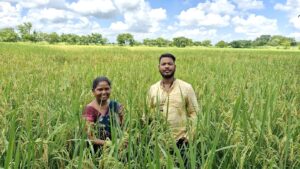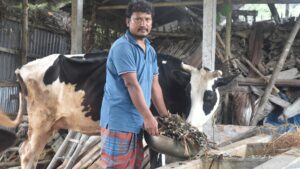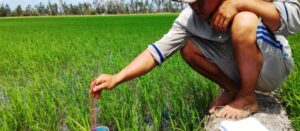by Mary Ng’endo, MaryLiza Kinyua, Lourine Chebet, Samuel Mutiga, Joseph Ndung’u, Oliver Nyongesa, Simon Njau, Ajay Panchbhai, Ruth Musila, and Rosemary Murori
In Kenya, Komboka can enhance food and nutrition security by increasing local rice production which will, in turn, contribute to a reduction of rice imports in the country. Its wide adaptability in both irrigated and rainfed lowland ecologies can lead to expansion in rice-growing areas that are currently not being cultivated. This paper discusses the factors that may be indicative of farmers’ perception and preference for modern rice varieties, focusing on Komboka as a case study. It is hypothesized that farmers’ perceptions of varietal quality could affect preferences for improved cultivars that may in turn bolster commercialization.
In Kenya, most middle-class consumers prefer aromatic rice varieties, which come at a premium market price. However, most lower-income households and local institutions with mass numbers consume imported rice as it is cheaper compared to the aromatic ‘pure pishori’ rice. For example, while the higher quality Mwea rice retails for a higher price of USD 1.20 to 1.80, Pakistan-imported rice retails USD 0.9 to 1.10
This gap for imported rice consumption can be filled by Komboka, which is high yielding (6.5 to 7.0 t/ha), semi-aromatic, medium slender, and translucent grain with intermediate plant height which makes it resistant to lodging. Cultivation of high-yielding semi-aromatic
Komboka can enhance food and nutrition security by increasing local rice production which will, in turn, contribute to a reduction of rice imports in the country. Its wide adaptability in both irrigated and rainfed lowland ecologies can lead to expansion in rice-growing areas that are currently not being cultivated. However, the rice seed replacement rate is very low and sometimes no data on seed access is available.
Moreover, there is low private sector interest in rice seed production and marketing since Komboka is an inbred variety. Coupled with a limited human capacity to develop materials for pure seed production and other policy-related limitations, these key constraints need to be addressed for widespread preference for Komboka by the smallholder farmers.
This paper discusses the factors that may be indicative of farmers’ perception and preference for modern rice varieties, focusing on Komboka as a case study. It is hypothesized that farmers’ perceptions of varietal quality could affect preferences for improved cultivars that may in turn bolster commercialization.
Research has also shown that approaches that incorporate farmers’ preferences for various characteristics of rice in breeding programs and extension strategies that are geared towards providing accurate information for efficient and timely revision of farmer perceptions are needed to raise the adoption rate of new varieties.
This study contributes by showing how appropriate crop varieties can stimulate production growth in Kenya, a country that has an excellent environment for the production of high-quality rice. Expanding the production acreage and diversifying the quality of rice through the introduction of new varieties is a potential solution to insufficiency and also a way of saving the foreign exchange for use in items that cannot be produced locally.
Specifically, our study seeks to evaluate the factors affecting new rice varieties in Kenya, where we assessed the perceptions of both breeders and farmers on IR05N221, locally referred to as Komboka.
The focus of this paper was to document farmers’ perceptions and preferences for new varieties to support commercialization, with the case study of Komboka rice in East Africa. The release of Komboka involved multi-locational breeder trials in multiple East African countries.
Here, we report the general cultivar performance based on major traits and qualities as assessed during the field evaluation by breeders, combined with farmers’ perceptions derived from focus group discussions as well as in-depth interviews. The combined components were assembled in this study with a focus on highlighting the importance of integrating the biophysical and social aspects of varietal adoption in Africa.
High-yielding, market-demanded rice varieties go hand in hand with high productivity levels as well as quality production, accessibility, and replacement of seeds. Concomitantly, enabling factors such as the ability of farmers to afford farm inputs, beneficial policies for farmers and seed producers, as well as good infrastructure, are also a prerequisite.
In addition to the availability of Komboka rice variety in Kenya and other countries, we recommend:
1. Working with seed dealers to boost availability, accessibility, and affordability of seeds of Komboka rice variety to smallholder farmers.
2. More demonstration and other popularization efforts to increase awareness about Komboka to all value chain stakeholders.
3. Value addition such as the introduction of biofortified Komboka containing essential minerals such as zinc and iron, which will also bolster nutrition security among the burgeoning population consuming rice.
4. Strengthening the capacity of extension agents so that they are better equipped to enhance farmers’ good agricultural management of the rice crop.
5. Conducting evaluations of Komboka to assess and optimize how it competes with imported rice varieties, especially in terms of market and sensory attributes.
6. To enhance better access of rice farmers to the local market, multiple strategies should be implemented. First, the adoption of pre- and post-harvest technologies that would reduce the cost of rice production, including the use of machines at different levels of the value chain. Second, the creation of awareness among the farmers for the existence of alternative varieties that could be acceptable to farmers. This could be coupled with exhibitions and promotional activities by government extension agencies for alternative varieties of rice. Third, the expansion of land under rice cultivation through the provision of more water for irrigation—this is currently being implemented by expanding the local water dam. Increasing the land under rice production would attract more farmers and/or larger land sizes per individual grower and hence the farmers would enjoy some increased benefits of large-scale production.
The aforementioned factors will enable the provision of prerequisite information that can support the commercialization and promotion of the new Komboka rice variety.
Read the study:
Ng’endo, M., Kinyua, M., Chebet, L. et al. (2022) The importance of market signals in crop varietal development: lessons from Komboka rice variety. CABI Agric Biosci 3, 57.






